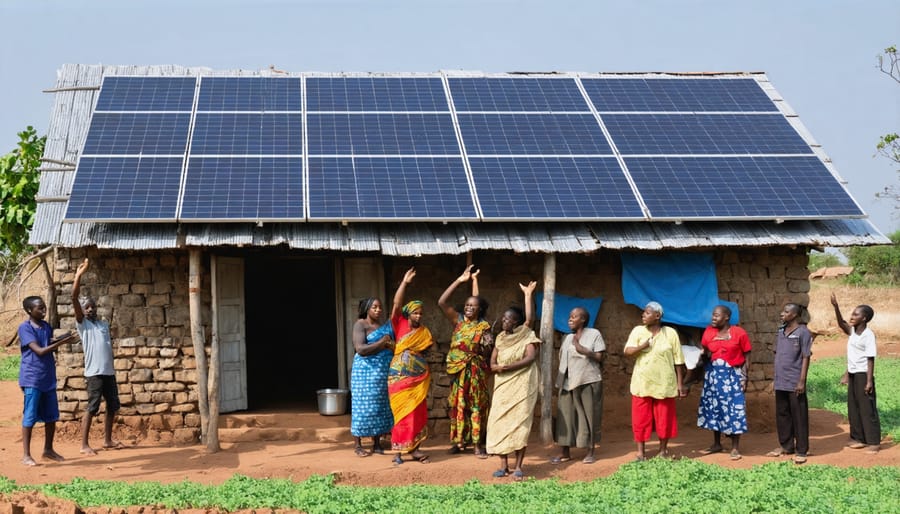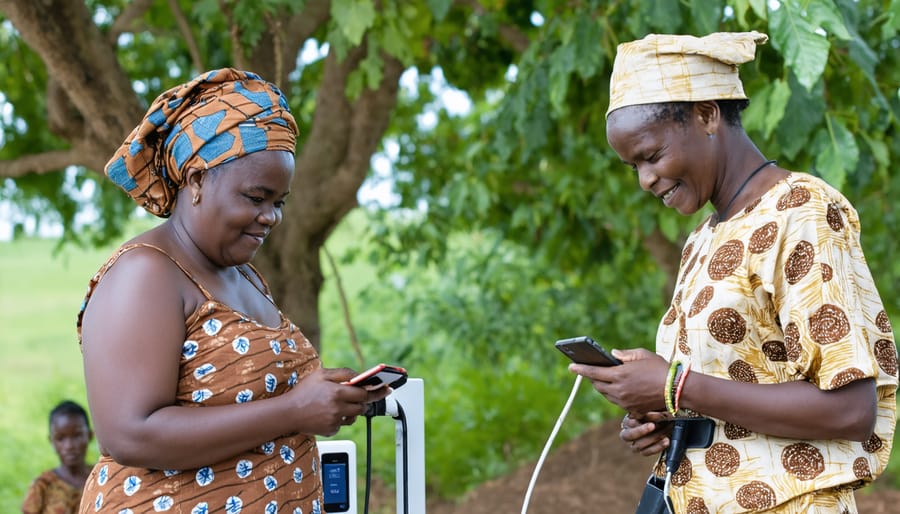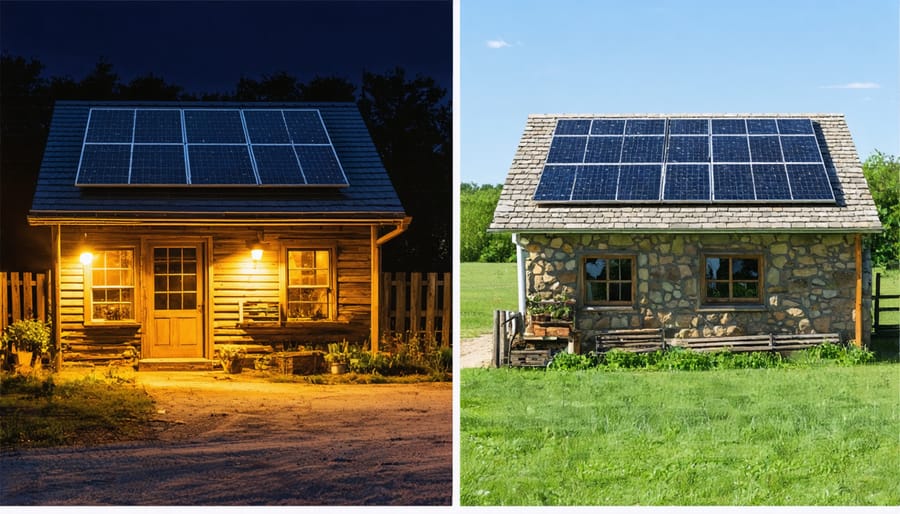Zambia’s solar energy revolution stands at a pivotal moment, driving unprecedented economic growth and rural electrification across the nation. As solar microgrids transform communities from the Copperbelt to Eastern Province, innovative financing models and public-private partnerships are accelerating adoption rates by over 200% annually. With 2.8 million households still lacking reliable electricity access, Zambia’s commitment to achieving 50% solar energy penetration by 2030 presents compelling opportunities for investors and developers. The convergence of declining solar technology costs, supportive government policies, and robust international funding mechanisms has created an ideal environment for sustainable energy development. This transformation isn’t just about power generation – it’s reshaping Zambia’s economic landscape, creating thousands of skilled jobs, and establishing the country as a regional leader in renewable energy adoption.
The Solar Energy Landscape in Zambia
Current Energy Access Challenges
Despite Zambia’s significant progress in renewable energy adoption, substantial challenges persist in achieving widespread energy access. Currently, only 31% of the rural population has access to electricity, compared to 67% in urban areas. This disparity creates significant socioeconomic barriers for rural communities and businesses.
Grid infrastructure limitations present a major obstacle, with many remote areas lying beyond the reach of traditional power lines. The high cost of grid extension, combined with challenging terrain and dispersed populations, makes conventional electrification economically unfeasible in many regions.
Financial constraints also impact both providers and consumers. Initial solar installation costs remain prohibitive for many households and small businesses, while limited access to credit and financing options further compounds the problem. Additionally, the lack of technical expertise in rural areas creates maintenance and sustainability challenges for existing solar installations.
Supply chain disruptions and limited availability of quality solar components affect system reliability and maintenance. These challenges are compounded by regulatory uncertainties and the need for more standardized quality control measures in the solar energy sector, which can deter potential investors and slow market growth.
Solar Potential and Opportunities
Zambia’s geographical location near the equator provides exceptional solar resources, with average daily solar radiation levels of 5.5 kWh/m² and over 3,000 hours of sunshine annually. This abundant solar potential, combined with the country’s growing energy demands and rural electrification needs, creates significant opportunities for solar power development.
Market assessments indicate that Zambia’s solar sector could attract investments exceeding $2 billion by 2030. The country’s commitment to achieving 50% renewable energy in its energy mix by 2030 further strengthens the market outlook. Rural areas, where approximately 95% of the population lacks grid connectivity, represent a particularly promising market for solar solutions.
The government’s supportive regulatory framework, including tax incentives for solar equipment and the introduction of feed-in tariffs, has created a favorable environment for both domestic and international investors. Recent successful utility-scale projects, such as the 54 MW Bangweulu solar plant, demonstrate the viability of large-scale solar installations in Zambia.
Additionally, the growing demand for commercial and industrial solar solutions presents opportunities for businesses seeking to reduce operational costs and enhance energy security.
Innovative Microfinance Solutions for Solar Access

Pay-As-You-Go Solar Systems
Pay-As-You-Go (PAYG) solar systems have revolutionized access to clean energy in Zambia by implementing smart solar financing solutions that make renewable energy accessible to a broader population. This innovative financing model allows customers to make incremental payments through mobile money platforms, effectively breaking down the significant upfront costs traditionally associated with solar installations.
In Zambia, leading PAYG providers have successfully deployed systems that combine solar panels, batteries, and basic appliances with sophisticated payment technology. Customers typically make an initial deposit of 10-15% of the total system cost, followed by regular payments over 12-36 months. Once the payment schedule is completed, customers own their systems outright.
The implementation of PAYG models has shown remarkable success, with collection rates exceeding 90% across major providers. These systems typically include:
– Remote monitoring capabilities
– Mobile payment integration
– Automated system lockout for missed payments
– Flexible payment schedules aligned with income patterns
– Technical support and maintenance services
Real-world data from Zambian PAYG implementations demonstrates that households save approximately 30-40% on their energy expenses compared to traditional fuel sources. This model has proven particularly effective in rural areas, where grid connection is either unavailable or cost-prohibitive.
For businesses and community facilities, larger PAYG systems offer scalable solutions that can grow with increasing energy demands. The model’s success has attracted significant investment from international development agencies and private sector partners, further expanding its reach across Zambia’s provinces.
Community-Based Lending Programs
Community-based lending programs have emerged as a crucial catalyst for solar energy adoption in Zambia, particularly in rural and peri-urban areas. These innovative financing mechanisms leverage the power of collective responsibility and social cohesion to make solar solutions accessible to communities that traditionally lack access to conventional banking services.
The Pay-As-You-Go (PAYG) community model has proven particularly successful, with village banking groups collectively purchasing solar systems and managing repayments through a shared responsibility framework. For example, the Lundazi Solar Community Initiative demonstrated how 50 households pooled resources to acquire solar home systems, achieving a 95% repayment rate through their group solidarity structure.
Several microfinance institutions (MFIs) have partnered with solar providers to offer specialized group lending products. These programs typically require community members to form groups of 10-15 households, who then cross-guarantee each other’s loans. The group mechanism reduces default risks for lenders while providing members with more favorable interest rates and flexible repayment terms.
Village savings and loan associations (VSLAs) have also integrated solar financing into their operations. These self-managed groups collect regular savings from members and provide loans for solar equipment purchases. The Chipata Solar Cooperative, for instance, has helped over 200 families transition to solar power through its community savings program.
Success factors for these programs include:
– Regular community meetings and financial literacy training
– Transparent management of group funds
– Technical support from solar providers
– Integration with existing community structures
– Performance-based incentives for timely repayments
These community-based approaches not only facilitate solar adoption but also strengthen social bonds and economic resilience within participating communities.

Success Stories and Impact Assessment
Rural Electrification Projects
Several successful rural electrification projects have demonstrated the transformative potential of solar energy in Zambia’s remote communities. The Lundazi District Solar Mini-Grid Project, implemented in 2018, serves as a prime example of effective rural electrification. This initiative has connected over 300 households and several small businesses to reliable solar power, enabling extended operating hours and improved economic activities.
In Eastern Province, the Renewable Energy for Rural Electrification (REF-RE) program has established solar-powered mini-grids in five villages, benefiting approximately 2,500 residents. The project’s success lies in its community-driven approach, where local stakeholders participate in both implementation and maintenance, ensuring long-term sustainability.
The Chirundu Solar Project, launched in 2019, demonstrates the effectiveness of public-private partnerships in rural electrification. This installation powers a local health center, school, and 150 households, showcasing how strategic solar deployment can support essential services while improving living standards. The project’s pay-as-you-go model has achieved a 95% payment compliance rate, proving the financial viability of rural solar initiatives.
Another notable success story is the Shangombo District Solar Initiative, which combines agricultural development with renewable energy access. Solar-powered irrigation systems have enabled year-round farming activities, while excess power supplies domestic needs for 200 households. This integrated approach has resulted in a 40% increase in agricultural productivity and created sustainable income opportunities for local communities.
These projects highlight key success factors in rural solar implementation: strong community engagement, sustainable business models, and comprehensive technical training for local maintenance teams. The evidence from these initiatives suggests that well-planned solar projects can deliver both social and economic benefits while maintaining financial sustainability. Future rural electrification efforts in Zambia continue to build upon these proven models, adapting them to meet specific local conditions and needs.

Economic and Social Benefits
The implementation of solar energy initiatives across Zambia has generated substantial economic benefits of solar power, creating a ripple effect of positive change throughout local communities. Recent studies indicate that solar projects have created over 5,000 direct jobs in installation, maintenance, and sales, with an additional 3,000 indirect employment opportunities in supporting industries.
Rural electrification through solar power has enabled the establishment of new small businesses, extending operating hours and increasing productivity. Local enterprises report an average 30% increase in revenue after gaining reliable access to electricity. Agricultural operations have particularly benefited, with solar-powered irrigation systems improving crop yields by up to 40% and reducing water consumption by 25%.
Educational outcomes have shown marked improvement, with students in solar-powered schools studying 2.5 hours longer per day on average. Healthcare facilities equipped with solar systems report enhanced ability to store vaccines, operate medical equipment, and provide emergency services around the clock, serving 35% more patients annually.
The reduction in household energy expenses has been significant, with families saving approximately 60% on their monthly energy costs compared to traditional fuel sources. These savings are typically reinvested in education, healthcare, and business expansion, creating a sustainable cycle of economic growth.
Women’s empowerment has emerged as a notable outcome, with female entrepreneurs leading 40% of solar-related businesses in rural areas. This has contributed to more balanced economic participation and improved household decision-making power.
The environmental impact aligns with economic benefits, as solar adoption has reduced carbon emissions by an estimated 50,000 tons annually while decreasing deforestation rates by 30% in electrified areas. This environmental preservation supports sustainable agriculture and tourism opportunities, further diversifying local economies.
Future Outlook and Scaling Opportunities
Zambia’s solar energy sector shows tremendous potential for growth, with experts projecting a significant expansion in both rural and urban installations over the next decade. The combination of declining equipment costs, improving solar energy innovations, and increasing government support creates an opportune environment for scaling existing projects.
Key growth areas include expanding mini-grid systems to serve additional rural communities, implementing large-scale solar farms to supplement the national grid, and increasing commercial installations for businesses seeking energy independence. The potential for job creation in installation, maintenance, and technical support roles presents significant economic opportunities.
To maximize scaling potential, stakeholders should focus on three primary strategies:
1. Strengthen public-private partnerships to facilitate larger infrastructure projects and improve distribution networks
2. Expand financing options through microfinance institutions and mobile payment systems to make solar solutions more accessible
3. Develop standardized training programs to build local technical capacity and ensure sustainable maintenance
Market analysis suggests that Zambia could achieve 50% solar energy penetration in rural areas by 2030, representing a substantial opportunity for investors and developers. The integration of battery storage solutions and smart grid technologies will play crucial roles in this expansion.
Recommendations for sustainable growth include:
– Establishing regional solar equipment manufacturing facilities to reduce import costs
– Creating specialized financing products tailored to different market segments
– Implementing quality control standards to maintain system reliability
– Developing clear regulatory frameworks to attract international investment
Success in scaling requires careful attention to community engagement, technical training, and maintaining affordable pricing structures. By focusing on these elements while leveraging technological advancements, Zambia’s solar sector can achieve significant growth while contributing to national energy security and environmental sustainability.
Zambia’s solar energy sector stands at a pivotal moment of growth and opportunity. The successful implementation of solar projects across the country has demonstrated the viability and impact of renewable energy solutions in addressing both rural electrification and urban energy needs. With decreasing technology costs, improved financing mechanisms, and strong government support, the foundation for widespread solar adoption is firmly in place. Business leaders and stakeholders are encouraged to leverage these favorable conditions by investing in solar infrastructure, participating in public-private partnerships, and supporting community-based initiatives. By taking action now, organizations can not only contribute to Zambia’s sustainable energy future but also benefit from significant cost savings and energy independence. The momentum in Zambia’s solar sector presents a clear path forward for those ready to embrace clean, reliable, and economically advantageous energy solutions.

